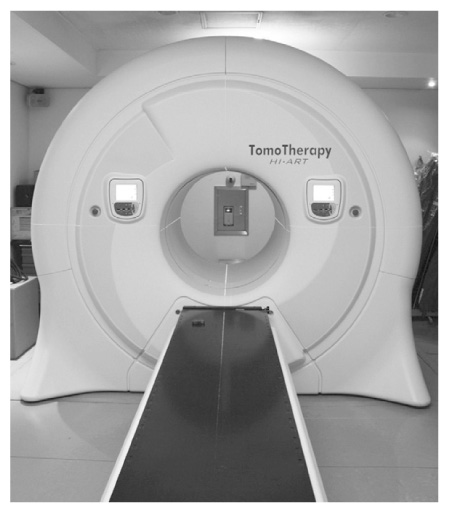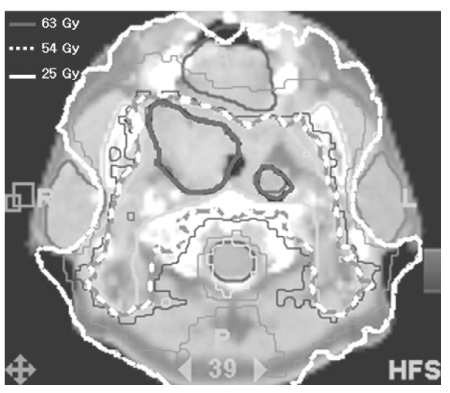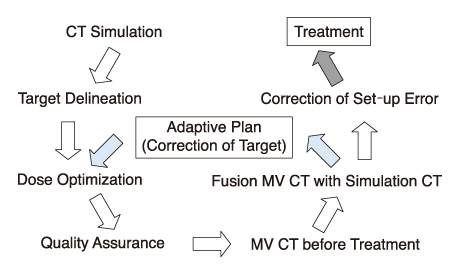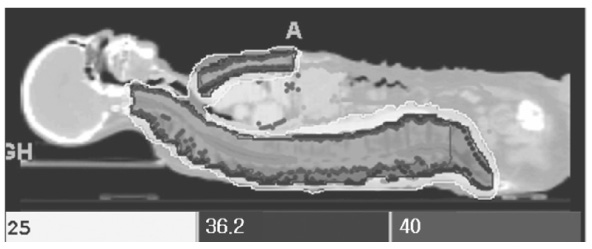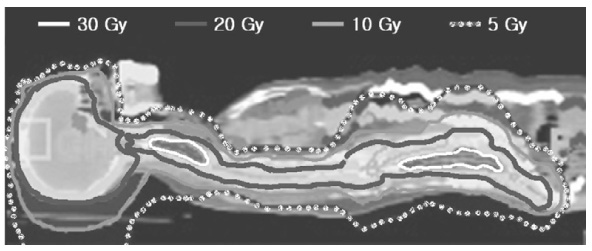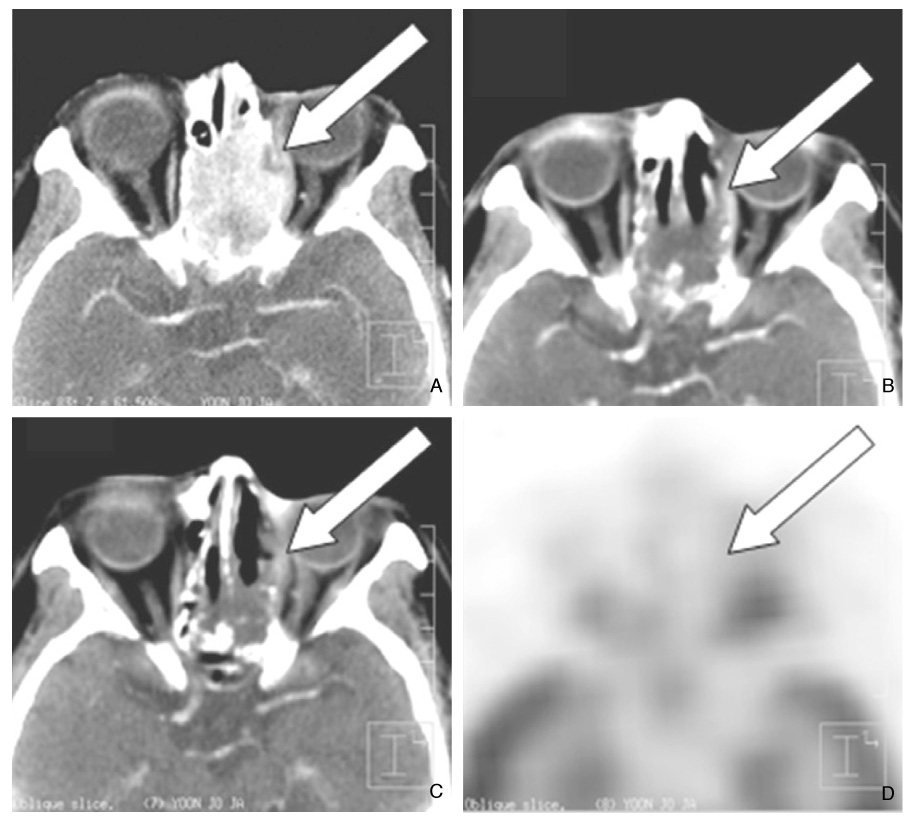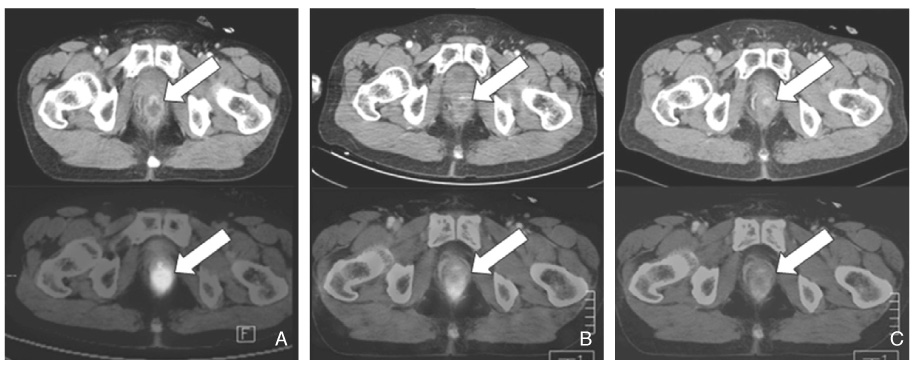J Korean Med Assoc.
2008 Jul;51(7):619-629. 10.5124/jkma.2008.51.7.619.
Helical Tomotherapy: Image-guided Intensity Modulated Radiation Therapy
- Affiliations
-
- 1Department of Radiation Oncology, Yonsei University College of Medicine, Korea. kckeum@yuhs.ac
- KMID: 2185912
- DOI: http://doi.org/10.5124/jkma.2008.51.7.619
Abstract
- Helical tomotherapy is an image-guided, intensity-modulated radiation therapy delivery system, a hybrid between a linear accelerator and a helical CT scanner. With its unique design features, tomotherapy has improved dose conformity and homogeneity of the target volumes, and conformal avoidance of the adjacent normal tissues. The daily pretreatment megavoltage computed tomography (MVCT) is a powerful tool used in image guided treatment delivery and patient setup verification. If anatomic changes occur during the course of treatment, MVCT images are utilized in correcting target volumes and constructing appropriate adaptive plans. Helical tomotherapy can be applied to more complicated cases, where conventional techniques find their limits: complex tumors with critical organ sparing, simultaneous irradiation of multiple targets, large volume and large superficial tumor irradiation, and recurrent tumor re-irradiation are a few examples. Tomothearpy may change the current paradigm in radiation oncology in the near future. Further studies regarding clinical implementation and treatment outcome of helical tomotherapy will be needed.
Keyword
MeSH Terms
Figure
Reference
-
1. Mackie TR. History of tomotherapy. Phys Med Biol. 2006. 51:R427–R453.
Article2. Whitelaw GL, Blasiak-Wal I, Cooke K, Usher C, Macdougall ND, Plowman PN. A dosimetric comparison between two intensity-modulated radiotherapy techniques: tomotherapy vs dynamic linear accelerator. Br J Radiol. 2008. 81:333–340.
Article3. Fenwick JD, Tomé WA, Soisson ET, Mehta MP, Mackie TR. Tomotherapy and other innovative IMRT delivery systems. Semin Radiat Oncol. 2006. 16:199–208.
Article4. Tomé WA, Jaradat HA, Nelson IA, Ritter MA, Mehta MP. Helical tomotherapy: image guidance and adaptive dose guidance. Front Radiat Ther Oncol. 2007. 40:162–178.
Article5. Fenwick JD, Tomé WA, Kissick MW, Mackie TR. Modelling simple helically delivered dose distributions. Phys Med Biol. 2005. 50:1505–1517.
Article6. Kron T, Grigorov G, Yu E, Yartsev S, Chen JZ, Wong E, Rodrigues G, Trenka K, Coad T, Bauman G, Van Dyk J. Planning evaluation of radiotherapy for complex lung cancer cases using helical tomotherapy. Phys Med Biol. 2004. 49:3675–3690.
Article7. Wieland P, Dobler B, Mai S, Hermann B, Tiefenbacher U, Steil V, Wenz F, Lohr F. IMRT for postoperative treatment of gastric cancer: covering large target volumes in the upper abdomen: a comparison of a step-and-shoot and an arc therapy approach. Int J Radiat Oncol Biol Phys. 2004. 59:1236–1244.
Article8. van Vulpen M, Field C, Raaijmakers CP, Parliament MB, Terhaard CH, MacKenzie MA, Scrimger R, Lagendijk JJ, Fallone BG. Comparing step-and-shoot IMRT with dynamic helical tomotherapy IMRT plans for head-and-neck cancer. Int J Radiat Oncol Biol Phys. 2005. 62:1535–1539.
Article9. Yartsev S, Kron T, Cozzi L, Fogliata A, Bauman G. Tomotherapy planning of small brain tumours. Radiother Oncol. 2005. 74:49–52.
Article10. Soisson ET, Tomé WA, Richards GM, Mehta MP. Comparison of linac based fractionated stereotactic radiotherapy and tomotherapy treatment plans for skull-base tumors. Radiother Oncol. 2006. 78:313–321.
Article11. Khoo VS, Oldham M, Adams EJ, Bedford JL, Webb S, Brada M. Comparison of intensity-modulated tomotherapy with stereotactically guided conformal radiotherapy for brain tumors. Int J Radiat Oncol Biol Phys. 1999. 45:415–425.
Article12. Fiorino C, Dell'Oca I, Pierelli A, Broggi S, De Martin E, Di Muzio N, Longobardi B, Fazio F, Calandrino R. Significant improvement in normal tissue sparing and target coverage for head and neck cancer by means of helical tomotherapy. Radiother Oncol. 2006. 78:276–282.
Article13. Sheng K, Molloy JA, Read PW. Intensity-modulated radiation therapy (IMRT) dosimetry of the head and neck: a comparison of treatment plans using linear accelerator-based IMRT and helical tomotherapy. Int J Radiat Oncol Biol Phys. 2006. 65:917–923.
Article14. Lee TK, Rosen II, Gibbons JP, Fields RS, Hogstrom KR. Helical tomotherapy for parotid gland tumors. Int J Radiat Oncol Biol Phys. 2008. 70:883–891.
Article15. Mackie TR, Olivera GH, Kapatoes JM. Palta JR, Mackie TR, editors. Helical tomotherapy. Intensity-modulated radiation therapy-the state of the art. 2003. Madison, WI: Medical Physics Publishing;247–284.16. Welsh JS, Bradley K, Ruchala KJ, Mackie TR, Manon R, Patel R, Wiederholt P, Lock M, Hui S, Mehta MP. Megavoltage computed tomography imaging: a potential tool to guide and improve the delivery of thoracic radiation therapy. Clin Lung Cancer. 2004. 5:303–306.
Article17. Welsh JS, Lock M, Harari PM, Tomé WA, Fowler J, Mackie TR, Ritter M, Kapatoes J, Forrest L, Chappell R, Paliwal B, Mehta MP. Clinical implementation of adaptive helical tomotherapy: a unique approach to image-guided intensity modulated radiotherapy. Technol Cancer Res Treat. 2006. 5:465–479.
Article18. Welsh JS, Patel RR, Ritter MA, Harari PM, Mackie TR, Mehta MP. Helical tomotherapy: an innovative technology and approach to radiation therapy. Technol Cancer Res Treat. 2002. 1:311–316.
Article19. Butler EB, Teh BS, Grant WH 3rd, Uhl BM, Kuppersmith RB, Chiu JK, Donovan DT, Woo SY. SMART (simultaneous modulated accelerated radiation therapy) boost: a new accelerated fractionation schedule for the treatment of head and neck cancer with intensity modulated radiotherapy. Int J Radiat Oncol Biol Phys. 1999. 45:21–32.
Article20. Chao KS, Ozyigit G, Tran BN, Cengiz M, Dempsey JF, Low DA. Patterns of failure in patients receiving definitive and postoperative IMRT for head-and-neck cancer. Int J Radiat Oncol Biol Phys. 2003. 55:312–321.
Article21. Claus F, De Gersem W, De Wagter C, Van Severen R, Vanhoutte I, Duthoy W, Remouchamps V, Van Duyse B, Vakaet L, Lemmerling M, Vermeersch H, De Neve W. An implementation strategy for IMRT of ethmoid sinus cancer with bilateral sparing of the optic pathways. Int J Radiat Oncol Biol Phys. 2001. 51:318–331.
Article22. Dawson LA, Anzai Y, Marsh L, Martel MK, Paulino A, Ship JA, Eisbruch A. Patterns of local-regional recurrence following parotid-sparing conformal and segmental intensity-modulated radiotherapy for head and neck cancer. Int J Radiat Oncol Biol Phys. 2000. 46:1117–1126.
Article23. Eisbruch A, Marsh LH, Dawson LA, Bradford CR, Teknos TN, Chepeha DB, Worden FP, Urba S, Lin A, Schipper MJ, Wolf GT. Recurrences near base of skull after IMRT for head-and-neck cancer: implications for target delineation in high neck and for parotid gland sparing. Int J Radiat Oncol Biol Phys. 2004. 59:28–42.
Article24. Lee N, Xia P, Quivey JM, Sultanem K, Poon I, Akazawa C, Akazawa P, Weinberg V, Fu KK. Intensity-modulated radiotherapy in the treatment of nasopharyngeal carcinoma: an update of the UCSF experience. Int J Radiat Oncol Biol Phys. 2002. 53:12–22.
Article25. Schultheiss TE, Wong J, Liu A, Olivera G, Somlo G. Image-guided total marrow and total lymphatic irradiation using helical tomotherapy. Int J Radiat Oncol Biol Phys. 2007. 67:1259–1267.
Article26. Wong JY, Liu A, Schultheiss T, Popplewell L, Stein A, Rosenthal J, Essensten M, Forman S, Somlo G. Targeted total marrow irradiation using three-dimensional image-guided tomographic intensity-modulated radiation therapy: an alternative to standard total body irradiation. Biol Blood Marrow Transplant. 2006. 12:306–315.
Article27. Smith KS, Gibbons JP, Gerbi BJ, Hogstrom KR. Measurement of superficial dose from a static tomotherapy beam. Medical physics. 2008. 35:769–774.
Article28. Ramsey CR, Seibert RM, Robison B, Mitchell M. Helical tomotherapy superficial dose measurements. Medical physics. 2007. 34:3286–3293.
Article29. Scrimger RA, Tomé WA, Olivera GH, Reckwerdt PJ, Mehta MP, Fowler JF. Reduction in radiation dose to lung and other normal tissues using helical tomotherapy to treat lung cancer, in comparison to conventional field arrangements. Am J Clin Oncol. 2003. 26:70–78.
Article
- Full Text Links
- Actions
-
Cited
- CITED
-
- Close
- Share
- Similar articles
-
- The using of megavoltage computed tomography in image-guided brachytherapy for cervical cancer: a case report
- Re-irradiation of unresectable recurrent head and neck cancer: using Helical Tomotherapy as image-guided intensity-modulated radiotherapy
- Comparison of survival rates between patients treated with conventional radiotherapy and helical tomotherapy for head and neck cancer
- Evolution of Radiotherapy: High-precision Radiotherapy
- Helical Tomotherapy in Elderly Prostate Cancer Patients

